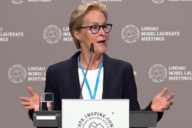You have /5 articles left.
Sign up for a free account or log in.
The number of international students enrolling in colleges in the United States rose by 5 percent in 2010-11, topping the 3 percent increase of the year before, and study abroad participation bounced back from a 0.8 percent decline last year, increasing 3.9 percent in 2009-10. The new totals -- 723,277 for foreign students in the U.S. and 270,604 for American students abroad -- are both records.
There were no big surprises in this year’s "Open Doors" report, the definitive look into study abroad and international student enrollment published annually by the Institute of International Education. The numbers suggest that both areas survived the economic recession that caused the slight but first-ever decline in study abroad in 2008-9 – and have come back swinging.
“It’s really catching on around the world that this is a central part of education,” said Allan E. Goodman, president and CEO of IIE. But, he added, there’s room for many more American students to study abroad: while 270,604 did so in 2009-10, the report notes, that’s still less than 1 percent of the student population. “We have a long way to go and many, many more Americans, community colleges, baccalaureate and research universities ought to have an international component to their experience, and it’s really going to take every one of us to get there.”
Open Doors reports the most recent data available, which for international enrollment is the previous year’s and for study abroad is two years ago. But a glimpse into preliminary study abroad numbers from last year suggests participation continued to rise.
International Enrollment Rising Faster
For the fifth year in a row, international enrollment is on the upswing. International students comprised 3.5 percent of total university enrollment in 2010-11. Last year, more than 723,000 foreign students studied in the United States – 32 percent more than did so a decade ago. New enrollment increased 6 percent, compared to 1 percent the year before.
New International Students, by Enrollment Category
| Total 2010-11 | 1-year increase | 5-year increase | |
| Undergraduate | 84,543 | 6.5 % | 37.8 % |
| Graduate | 89,505 | 5.8 % | 39.3 % |
| Non-Degree | 40,442 | 3.7 % | 133.1 % |
| Total | 214,490 | 5.7 % | 50.1 % |
After a 29.9 percent increase helped China surpass India as the top-sending country last year, the country again sent more students than ever to the U.S. – 157,558, accounting for nearly 22 percent of total foreign enrollment, a 23.3 percent increase from the year before. China is also playing a big role in closing the numbers gap between undergraduate and graduate students – it sent 43 percent more undergraduates this year.
Historically, graduate students have dominated international enrollments in the United States. But in recent years, undergraduate international enrollments have surged, and there are now only 5,000 fewer undergraduates (291,439 total) than graduates. Last year the increases were 3.7 and 1.7 percent, respectively.
Following China, the countries sending the most students to the U.S. are India and South Korea. While they didn’t see the large increases China did -- and India actually sent 1 percent fewer students than it did last year -- they still account for 14.4 and 10.1 percent, respectively, of all international enrollment. (Those three countries in total account for 46 percent of all foreign enrollment, and the top seven places of origin, which also include Canada, Taiwan and Japan, account for nearly 60 percent.) Saudi Arabia continues to creep up the list of top-sending countries, thanks to a 43.6 percent increase this year that followed a 24.9 percent increase the year before. At No. 6 on the list, its 22,704 students comprise 3.1 percent of foreign enrollment.
| Country | Total | % of International Total | 1-Year Change |
| 1. China | 157,558 | 21.8 % | +23.3 % |
| 2. India | 103, 895 | 14.4 % | -1.0 % |
| 3. South Korea | 73,351 | 10.1 % | +1.7 % |
| 4. Canada | 27,546 | 3.8 % | -2.1 % |
| 5. Taiwan | 24,818 | 3.4 % | -7.0 % |
| 6. Saudi Arabia | 22,704 | 3.1 % | +43.6 % |
| 7. Japan | 21,290 | 2.9 % | -14.3 % |
| 8. Vietnam | 14,888 | 2.1 % | +13.5 % |
| 9. Mexico | 13,713 | 1.9 % | +2.0 % |
| 10. Turkey | 12,184 | 1.7 % | -1.7 % |
Goodman and Peggy Blumenthal, executive vice president and chief operating officer of IIE, don’t expect enrollments from China to slow down any time soon. “The kind of education that they can get here is really not able to be duplicated, either in a branch campus or in a partnership, or in a school, an institution in China,” Blumenthal said. “We just have a very different way of teaching and learning that is very attractive right now to Chinese parents and students.”
Blumenthal also believes that undergraduate enrollment will continue to rise. “I think it’s going to be neck-and-neck for a long time,” she said. “I don’t expect the number of undergraduate numbers to tail off any time soon.”
As is the norm, large research universities hosted the most students, with the University of Southern California leading the pack for the 10th year in a row with 8,615 students. The University of Illinois at Urbana-Champaign hosted 7,991 students, barely beating out New York University, which gave up the No. 2 spot to Illinois last year and could have reclaimed it this year had it hosted only four more students.
Study Abroad Rebounds
After a first-ever decline in 2008-09, the number of students studying abroad was back on the rise in 2009-10 with a 3.9 percent increase, setting a new participation record of 270,604 students. While last year’s preliminary study abroad survey had indicated the rebound would occur, colleges are still trying to find less expensive opportunities for students who are still feeling the effects of the recession, Blumenthal said.
“In terms of the commitment to study abroad,” she said, “that clearly is stronger than ever."
American students continue to spread out and study in places outside Europe, with growing interest in China, which saw a 1.7 percent increase to 13,910 students, landing it at No. 5 on the list of top destinations, and India, whose 44.4 percent increase resulted in its hosting 3,884 students. And like last year, 15 of the top 25 destinations were outside Western Europe, and 19 were not primarily English-speaking countries -- but still, Britain, Italy, Spain and France continue to be the most desirable locations for American students. Together they host about 38 percent of all study abroad participants.
| Country | Total | % of Study Abroad Total | 1-Year Change |
| 1. Britain | 32,683 | 12.1 % | +4.3 % |
| 2. Italy | 27,940 | 10.3 % | +2.1 % |
| 3. Spain | 25,411 | 9.4 % | +5.1 % |
| 4. France | 17,161 | 6.3 % | +1.5 % |
| 5. China | 13,910 | 5.1 % | +1.7 % |
| 6. Australia | 9,962 | 3.7 % | -10.6 % |
| 7. Germany | 8,551 | 3.2 % | +2.7 % |
| 8. Mexico | 7,157 | 2.6 % | -2.2 % |
| 9. Ireland | 6,798 | 2.5 % | -0.9 % |
| 10. Costa Rica | 6,262 | 2.3 % | -1.6 % |
Despite the continued dominance of those traditional destinations, Blumenthal attributes the slow-but-steady diversification to a number of things: students opting for less expensive options, curriculums that talk about regions other than Europe, more countries seeking American students, and more participation by students studying fields other than the typical social sciences and business, such as agriculture, which rose 22.8 percent, and engineering, which saw a 26.7 percent increase.
“That’s amazing for somebody like me, who’s been trying to get engineering students to study abroad for decades,” Blumenthal said. “I do think as the fields of study broaden out, so will the destinations. I think the career interests of American kids are driving their choices, to some extent. They know that getting a summer in China or a semester in India is going to be very helpful for their careers.”
Once again, students studying abroad are primarily white (78.7 percent) and female (63.5 percent), but participants are – very slowly – diversifying. The number of males and nonwhites has inched up a percent or so in each of the last two reports.
NYU and Michigan State University are again the top-sending institutions, sending 4,156 and 2,589 students, respectively, and the University of Southern California beat out the University of California at Los Angeles to claim the No. 3 spot with 2,500 students going abroad.
| Sector and College | Undergraduate Study Abroad Students | Estimated % Undergraduate Participation in Study Abroad |
| Doctoral | ||
| 1. University of San Diego | 825 | 71.4 % |
| 2. Pepperdine University | 591 | 70.2 % |
| 3. University of Denver | 824 | 69.7 % |
| 4. Yeshiva University | 610 | 67.9 % |
| 5. University of Saint Thomas | 796 | 61.8 % |
| Master's | ||
| 1. Hamline University | 467 | 106.9 % |
| 2. Lee University | 630 | 99.2 % |
| 3. Arcadia University | 491 | 98.4 % |
| 4. Elon University | 1,087 | 97.2 % |
| 5. University of Dallas | 234 | 91.4 % |
| Baccalaureate | ||
| 1. Austin College | 347 | 114.9 % |
| 2. Wofford College | 336 | 105.7 % |
| 3. Saint Olaf College | 745 | 104.1 % |
| 4. Earlham College | 207 | 97.6 % |
| 5. Goucher College | 321 | 97.0 % |
But while those institutions send the most students abroad, smaller privates have higher participation rates. The leaders there are the University of San Diego, Pepperdine University, and the University of Denver. Last year’s No. 3, Wake Forest University, dropped to No. 6 this year. (Participation rates are calculated by comparing the number of students who went abroad with the number of degrees the college conferred that year, so numbers can be skewed by students who study abroad multiple times or unusually large or small graduating classes -- which explains participation rates above 100 percent.)
What to Expect for Study Abroad in 2010-11
A survey conducted this fall indicates that, thanks in part to more faculty-led programs and institutions hiring additional staff, study abroad participation continued to rise in 2010-11.
While 30 percent of campuses reported fewer students studying abroad than did in 2009-10 and 27 percent reported no change, 53 percent said they saw higher participation. (In the fall 2010 survey, 55 percent of respondents had reported increases.)
This may be because many campuses have been proactive about sending students overseas. More than 60 percent said they added new short-term faculty-led programs, 36 percent partnered with new foreign institutions, and 30 percent “added staff members or increased staff time devoted to study abroad this year.” Twenty-seven percent, meanwhile said they increased the number of study abroad scholarships available.
Campuses also said that once again, more students are studying in China and India, but Western Europe continues to see the largest increase, of 48 percent. But big increases are also unfolding in Sub-Saharan Africa (36 percent) and Turkey (32 percent). The number of students going to Mexico and Japan, meanwhile, continue to decline.




